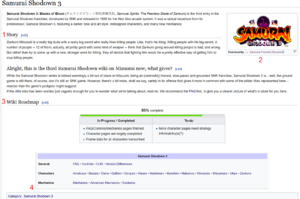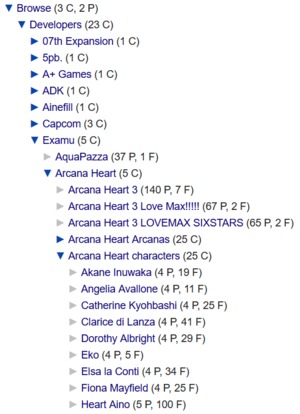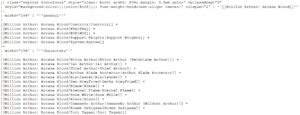Help:Starting a new wiki at Mizuumi
This guide is written assuming you already have an account at Mizuumi Wiki. If not, please follow the steps in Help:Getting started.
Before starting anything, you need admin approval. To query whether or not your game is suited for Mizuumi, fill out our application form. The admin team will respond to your request as soon as possible via Discord.
In recent time, Mizuumi has become the de-facto place to start a wiki for indie/poverty/niche fighting games. As long as a game meets the criteria and you get admin approval, getting a new game added to the site is rather effortless. There are several reasons we might reject a game, the most common reason being playerbase size. We will always offer our reasoning when rejecting games.
After receiving admin approval you're free to start setting up your game's wiki! There are certain steps that should be followed to avoid reinventing the wheel in the process. This article aims to help new editors learn the ropes of adding new wikis to the site.
Important details will be highlighted in red.
Optional but recommended suggestions will be highlighted in blue.
Step 1: Create the wiki's landing page
All wiki landing pages follow a similar structure:
{{Infobox Game}}which displays the game's information- Opening text describing game
- Release dates (with links) can be organized on a table.
- Examples: UNIST, Koihime Enbu, DFCI
- Section for Wiki Roadmap. For more information on how to use the Wiki's Roadmap go to Mizuumi Wiki:Roadmap.
- Adding a roadmap gives outside users an idea on where help is needed and keeps projects more accountable.
- Examples: Samurai Shodown, AH3LMSS
- Game
{{Navbox}}and category at the bottom of a page. All games need these two for easier navigation and proper cataloging respectively.- Navboxes should use the following naming convention, such as
{{Navbox-ABK}},{{Navbox-BFTG}},{{Navbox-EFZ}}and so on. - Categories should use the game's full name (
[[Category:KILL la KILL IF]]).
- Navboxes should use the following naming convention, such as
Keep in mind that some wikis on the site have barely been touched since the early 2010s. Therefore, if you want to use the code from another game's landing page, make sure you copy it from a recent wiki.
Categories are "behind-the-scenes labels" for the wiki. They're invisible to the regular visitors but can make life significantly easier for editors when trying to find stuff. Therefore, proper categorization is important when setting things up.
You probably created a placeholder category when setting up the landing page. You'll know since the red letters at the bottom means one hasn't been created yet. And what better way to create one than by using another category!
The main category at Mizuumi Wiki is called "Browse" and under it there's a category for developers in which you'll find the usual suspects when it comes to poverty fighting games: Examu, French-Bread, Twilight Frontier, and more. If the game you're adding to the site doesn't have their developer listed, no problem. Simply create the categories in the following order:
- Add line
[[Category:Developer Name]]inside[[Category:Game Name]] - Add line
[[Category:Developers]]inside[[Category:Developer Name]]in case the developer wasn't already listed at the wiki
Navigation bars, or navboxes go at the end of the landing page and every subpage of the wiki. The best way to go around making these is just to copy the code from the navbox of a recent game and adapt it to your needs. They usually have two to three rows:
- General: pages that won't change if an updated version comes in the future. Usually includes a FAQ, Controls, and a basic System Mechanics page.
- Advanced/Mechanics/System: pages that will change if an updated version comes in the future. These pages go more in depth to the changes particular to this version of the game or if the previously-mentioned System page in General becomes too big, it might be a good idea to split up in several pages that would be listed in this row.
- Characters: a list of the game's roster. Organized alphabetically or in the way they're displayed on the character select screen.
Games with assists/grooves might have a fourth row to list individual pages for them (DFCI, AH3LMSS). The character usually used as a divider for pages is • .
Step 3: Create the first character page
The first character page is the hardest, but if done properly it should make subsequent pages a lot easier. The majority of character pages at the wiki have the following structure. You don't have to follow this 1:1 but use it as a guideline:
- Introduction/Profile/Story
- An opening paragraph with some background info on the character. Stuff like "fluff" or "lol anime story" may have flied in the past but it's currently frowned upon. Samurai Shodown 3 is a great example of a wiki that is fun to read but it doesn't devolve into a shitpost.
- Data
- Some wikis have dedicated data pages with transcluded info to character pages, like Samurai Shodown.
- Overview/Strategy/Gameplan
- The first "mandatory" section. Here you should describe the character's gameplay archetype, summarize their strengths/weaknesses, and if possible have some sections on how to approach neutral, oki, and recommended assist/groove info (depending on the game).
- Normal Moves
- A list of normal moves. Subsections may include:
- Standing Normals
- Crouching Normals
- Air Normals
- Command Normals
- Dash Normals
- It is recommended that wikis for newer games to make use of the Universal MoveData Template:
{{MoveData}}- Create two branch templates
{{AttackData-Game}}and{{AttackDataHeader-Game}}for displaying data. - For information on how these templates work, take a look at the code for existing games that make use of them.
- Create two branch templates
- Universal Mechanics
- For moves that the entire cast may have access to.
- Examples: throws, Force Function in UNI, Issen in SamSho
- Special Moves
- Supers
- Some games have several super versions (UNI: IW/IWEX, MAAB: MS/ME). They can be put in subsections here.
- Combos
- A good notation for combos is:
*5A > 5B > 5C '''(Damage)''':Combo Explanation ("This is a simple magic series")
- Videos
- They can be listed in bullets or making use of the EmbedVideo Extension installed at Mizuumi.
- Colors
- Use
{{ColorGallery}}for basic character color display.
- Use
- External Links
- Add links to any relevant content on Google Docs/Evernotes/Pastebins/Twitter that is relevant to a character.
Step 4: Ask for feedback
This is a key section that historically a lot of editors fail to cover. Always ask for feedback from within your game community and on the Mizuumi server. Chances are you have a typo in the category or you missed a value in the movelist. Retroactively changing errors across all character pages after the fact is a pain in the ass.
DOUBLE CHECK EVERYTHING BEFORE CREATING THE REMAINING CHARACTER PAGES
Step 5: Make adjustments and create remaining pages
Once you have the green light from multiple collaborators, use the character page template to make the "skeleton" of all remaining pages. Some things to keep in mind:
- Character categories aren't mandatory but will help keep things tidy.
- Especially for characters with several games on the site (SamSho characters like Rimururu) or characters that keep crossing to other games (Heart Aino). Some of these characters will have hundreds of files for normals/specials/supers and adding them to a category serves as a "check" that the files are being on display.
- Transclusion saves a lot of work.
- Transcluding info like Twitter hashtags or character health values can help make modifications across several pages at once. For more info on the subject, go here.
- Japanese wikis usually have full or partial frame data
- Become acquainted with some basic JP terms or learn to navigate sites like atwiki.jp or seesaawiki.jp and you could find info that you'd have to otherwise create yourself.
Once this preliminary work is complete, contact the admins to get your new wiki added to the sidebar. The sidebar functions as a comprehensive directory of all wiki projects at Mizuumi, complete and ongoing. Once the editors consider a wiki has reached an important milestone (finishing all character and system pages for example) they may request it to be added to the front page for visibility.
Hope you found this guide useful, and if you have further questions feel free to ask in the Mizuumi Discord.


